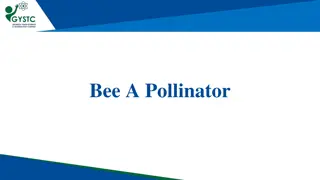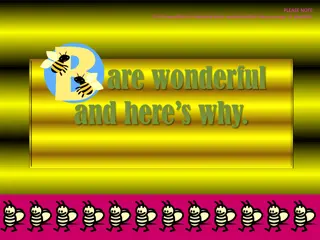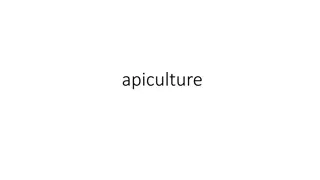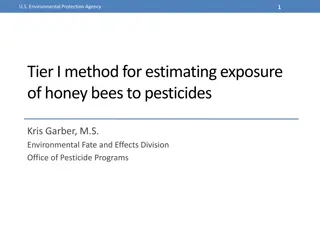Importance of Bees: Why We Need to Care About Them
Bees are essential pollinators, with various species playing crucial roles in ecosystems. They forage for pollen and nectar, create honey, and live in diverse habitats. Bumble bees, honey bees, and solitary bees each have unique characteristics and contribute to biodiversity. However, bees face threats from predators, human activities, and environmental changes, highlighting the need for conservation efforts to safeguard these vital insects.
Download Presentation

Please find below an Image/Link to download the presentation.
The content on the website is provided AS IS for your information and personal use only. It may not be sold, licensed, or shared on other websites without obtaining consent from the author.If you encounter any issues during the download, it is possible that the publisher has removed the file from their server.
You are allowed to download the files provided on this website for personal or commercial use, subject to the condition that they are used lawfully. All files are the property of their respective owners.
The content on the website is provided AS IS for your information and personal use only. It may not be sold, licensed, or shared on other websites without obtaining consent from the author.
E N D
Presentation Transcript
Bees and why we need to care about them!
Bees are insects. They have a three part body and six legs. They also have 2 pairs of wings. A honey bee
How many different bees are there? There are about 260 species of bee in the United Kingdom. Only one is a honey bee. There are about 17 Bumble Bee species. Honey bees and bumble bees are social bees and live as colonies. The other 230 types of bees are solitary, which means they live on their own.
What do bees eat? Adult bees forage for pollen and nectar, the sweet liquid produced by flowers. They feed the pollen to the young grubs in the hive or nest. Pollen has lots of protein. Adult bees use nectar to make honey in the hive. Honey is stored for winter.
Where do bees live? Honey bees in the wild make their nests in trees, sometimes using holes in trunks or branches People keep honey bees in bee hives which are usually made from wood.
Where do bees live? Bumble bees make small nests, often in the ground. Solitary bees live in lots of places, including in a hole in a wall or in the lawn.
What eats bees? Lots of animals, large or small, eat bees: Birds Spiders Wasps or ants Grasshoppers and crickets Bigger animals like bears My dog tries to catch bees! Humans kill bees, sometimes deliberately and sometimes by accident when using sprays in the garden.
Bumble Bees the gentle bee Bumble bees are not the same as honey bees. They only make a tiny bit of honey, enough to feed their young.
Bumble Bees (cont.) They are round and furry and fly a lot more slowly than honey bees. They rarely use their sting, and do not die when they do use it.
Honey Bees How many types of honey bee are there? Honey bees are very busy bees. They live in colonies with lots of other honey bees many thousands. Bees make and store honey to eat in autumn and winter. They make so much honey that people can take some without harming the bee colony.
A honey bee hive The hive Inside the hive
Collecting honey from the hive You must wear protective clothes!
Do you like honey? Jars of honey honeycomb
What shape are honeycomb cells? Inside the hive, the honey bees raise their young in cells. Each egg is laid in its own cell.
The grub hatches and grows in the cell. Worker bees feed the grubs with pollen.
What types of bee are in a hive? There are 3 types of bee: The Queen only 1 of these Drones males who do no work Workers, all females, who keep the hive tidy and fly out to find pollen and nectar
How do bees find food? When a worker bee is about 3 weeks old she can fly out of the nest to find flowers to collect nectar and pollen from. When she finds a good source of nectar she flies back to the hive and does a waggle dance . This tells other worker bees where to fly to find the good source of food.
Here is the really important bit! Why are we worried about bees? Bees are dying out. This is a problem for us. Besides feeding themselves when they collect pollen, bees do a very important job. They pollinate many, many of the plants we eat.
How does that affect us? Bees of all types pollinate more than half of the plants that grow food for us. If bees did not pollinate these plants, no fruits or seeds would develop. That means no apples, no pears, no tomatoes, no cherries, no strawberries, no cucumbers, no nuts, no beans, no .
How can we help look after bees? 1) Be a friend to bees they are not bad for us. If a bee is bothering you, stand still and it will go away. 2) Don t be scared of wild bees in the garden. Never harm a bees nest. 3) Plant lots of flowers so bees can find lots of food. 4) Join the BBC Radio Suffolk Bee Part of It campaign. http://www.bbc.co.uk/breathingplaces/beepartofit/























